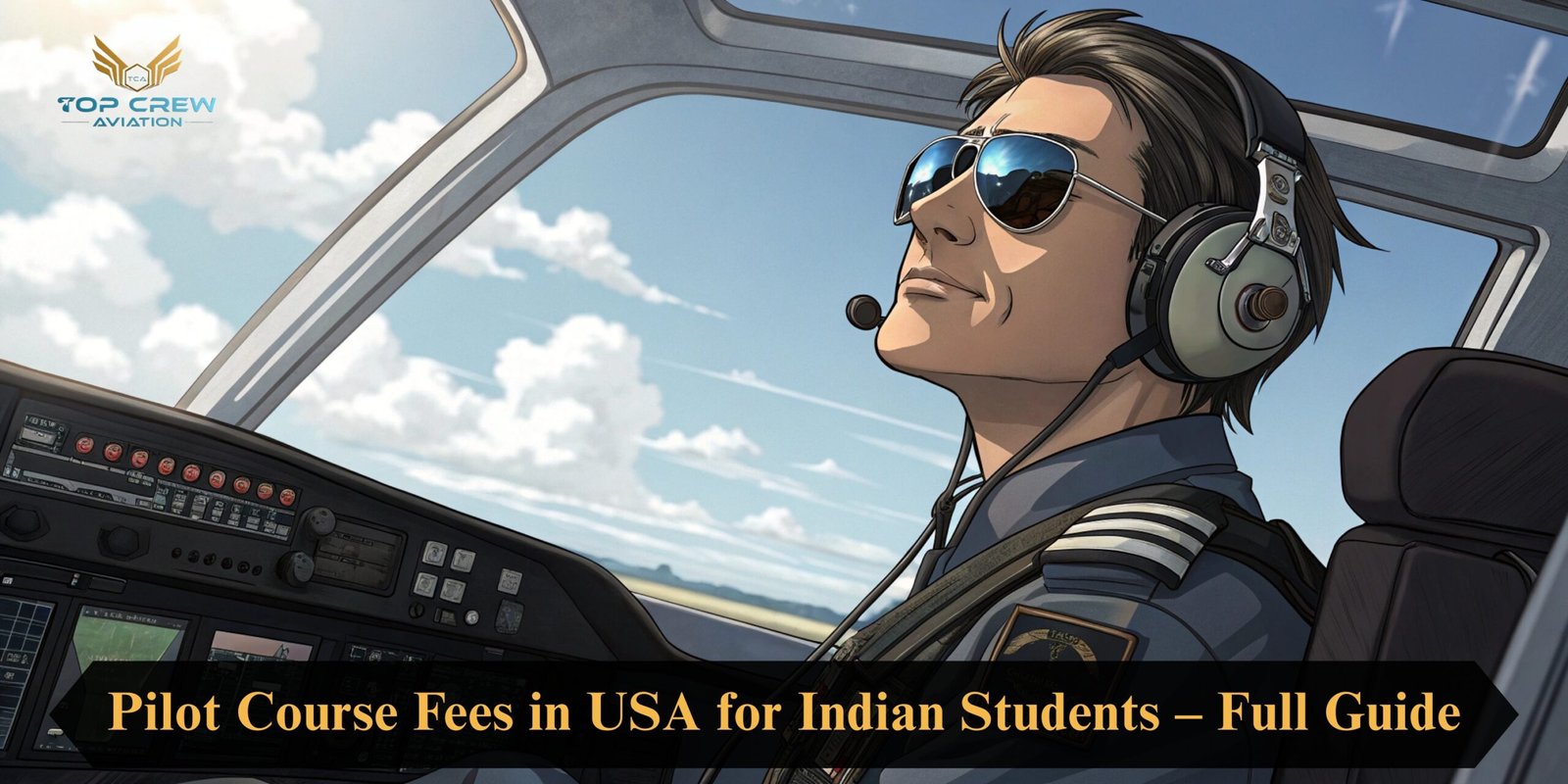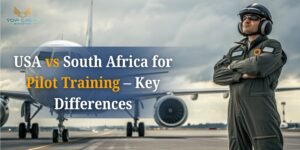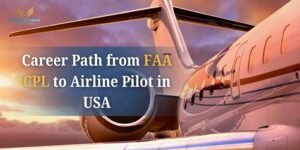Introduction
Becoming a pilot is not just a career choice—it’s the fulfilment of a lifelong dream to soar high above the clouds and explore the endless skies. The United States of America is one of the most popular destinations for pilot training in the USA, thanks to its world-class aviation infrastructure, highly experienced instructors, FAA (Federal Aviation Administration) licenses recognised globally, and faster training timelines compared to many other countries.
If you’re an aspiring pilot wondering, “How much does it cost to become a pilot in the USA?” or looking for clarity on Pilot Course Fees in USA, this comprehensive guide is for you. We will cover everything you need to know—from the qualifications required to the different types of pilot training courses in the USA, detailed fee breakdowns, living costs, money-saving tips, and how Top Crew Aviation can support you every step of the way.
Pilot Training Qualifications in the USA: What You Need to Know
Before you enroll in any pilot training program in the USA, you must meet certain basic requirements. These qualifications ensure you are ready and eligible for training:
- Age: You must be at least 17 years old to start training for a Private Pilot License (PPL) and at least 18 years old for a Commercial Pilot License (CPL).
- Education: A high school diploma or equivalent is required. A solid foundation in maths and physics is highly beneficial, as aviation involves technical knowledge.
- English Language Skills: You should be able to read, write, and speak English clearly, as it is the international language of aviation.
- Medical Fitness: Obtaining a valid FAA Class 1 or Class 2 medical certificate is mandatory. This involves a medical examination by an FAA-authorised aviation medical examiner to confirm you are fit to fly.
- Visa: International students usually require an M-1 vocational training visa to legally study aviation in the USA.
Pilot Course Types and Fees in the USA: What to Expect
The USA offers a range of pilot training courses, each tailored for different stages of a pilot’s career. Below is a breakdown of the most common pilot licenses and ratings, their purpose, and the typical fees involved:
| Course | Purpose | Average Cost (USD) | Average Cost (INR) |
| Private Pilot License (PPL) | The first step to fly for personal and recreational purposes (non-commercial). | $10,000 – $15,000 | ₹800,000 – ₹1,200,000 |
| Commercial Pilot License (CPL) | Required to fly commercially and get paid for flying. | $30,000 – $50,000 | ₹2,500,000 – ₹4,200,000 |
| Instrument Rating (IR) | Enables flying in poor weather and low visibility using instruments. | $8,000 – $10,000 | ₹6,50,000 – ₹8,00,000 |
| Multi-Engine Rating (MER) | Qualifies you to fly aircraft with more than one engine. | $3,000 – $5,000 | ₹400,000 – ₹650,000 |
| Certified Flight Instructor (CFI) | Allows you to train other pilots and earn money while accumulating flying hours. | $5,000 – $8,000 | ₹400,000 – ₹650,000 |
Note:- These fees may vary based on flight school, location, and aircraft type.
What Does the Pilot Training Fee Cover?
Pilot training fees typically include several key components:
- Tuition & Flight Hours (50–60%) – Covers ground school lessons, flight training hours with an instructor, and simulator time.
- Aircraft Rental – Hourly rates vary depending on whether you’re training on single-engine or multi-engine aircraft.
- Exams & Checkrides – Fees for FAA written exams and practical flight tests to evaluate your skills.
- Medical Certification – Costs for FAA medical exams (Class 1 or 2).
- Study Materials – Manuals, charts, and navigation tools you’ll need to study and practice.
- License & Certification Fees – Processing fees for your FAA licenses and certificates.
Additional Costs to Budget for Pilot Training in the USA
Besides the direct training fees, aspiring pilots should plan for these living and administrative expenses during their stay:
- Accommodation: Depending on the location, rent can range between $500 and $1,000 per month. Smaller cities tend to be more affordable than metropolitan areas.
- Living Expenses: Budget around $800 to $1,200 per month for food, transportation, utilities, and other daily costs.
- Visa & SEVIS Fees: These are mandatory for international students and typically range from $350 to $500.
- Travel Costs: Round-trip airfare from your home country to the USA.
- Health and Travel Insurance: To cover medical emergencies and travel risks during your stay.
Key Factors Affecting the Overall Cost of Pilot Training in the USA
Your total investment in pilot training in the USA will vary based on several factors:
- Flight School Location: Training in smaller towns usually costs less than in major cities.
- Type of Aircraft: Newer and more advanced aircraft often come with higher rental costs.
- Instructor Experience: Highly experienced instructors may charge premium rates.
- Learning Pace: The faster you progress, the fewer hours you need, lowering costs. Conversely, additional practice hours add to the total fee.
- Fuel Prices: Fluctuating aviation fuel prices impact hourly flight costs.
USA vs India: Pilot Training Cost & Career Comparison
| Criteria | USA | India |
| License | FAA (Recognized Worldwide) | DGCA (Indian License) |
| Training Duration | 12–18 months | 18–24 months |
| Total Cost (approx.) | ₹4,500,000 – ₹65,00,000 | ₹45,00,000 – ₹65,00,000 |
| Infrastructure | Advanced aviation technology | Moderate infrastructure |
| Global Job Opportunities | High (due to FAA license) | Limited global recognition |
Verdict: Although the costs are somewhat comparable, pilot training in the USA offers quicker completion times, more modern aircraft, and an FAA license recognized globally—opening doors to international career opportunities.
Money-Saving Tips for Pilot Training in the USA
Pilot training is a significant investment, but these tips can help you reduce costs without compromising quality:
- Choose flight schools located in smaller cities or towns to reduce accommodation and living expenses.
- Fly consistently to maintain your skills and avoid accumulating extra hours.
- Consider package training deals, which often cost less than paying hourly rates separately.
- Prepare well for exams to avoid costly retakes.
- After gaining your Commercial Pilot License, becoming a Certified Flight Instructor (CFI) can help you earn while you build your flying hours.
How Top Crew Aviation Supports Your Pilot Journey in the USA
Navigating pilot training abroad can be challenging. That’s where Top Crew Aviation steps in to make your journey smooth and successful:
- Counselling & Career Guidance: Personalised advice to help you choose the best career path and course based on your goals.
- Flight School Selection: Access to reputed and FAA-approved flight schools across the USA through our strong partnerships.
- Visa Assistance: Complete help with your M-1 visa application and necessary documentation to study in the USA legally.
- Pre-Departure Training: Ground school preparation and orientation to get you ready before you fly to the USA.
- Post-Training Support: Assistance in converting your FAA license to DGCA and help with job placement guidance.
Why Choose Top Crew Aviation?
- A team of experienced aviation experts and certified instructors committed to your success.
- Strong global network with leading US flight schools for quality training options.
- Transparent, affordable training packages tailored to your budget.
- End-to-end support from admission to career launch.
Conclusion
Pilot training in the USA requires a significant financial commitment but offers unmatched benefits in terms of quality education, cutting-edge facilities, and a globally recognised FAA license. While the
pilot course fees in USA can vary depending on the program and location, the faster training timeline, superior infrastructure, and international career prospects make this investment worthwhile.
With Top Crew Aviation by your side, you don’t just get admission assistance—you gain a reliable partner dedicated to helping you reach your dream of becoming a professional pilot.
Top 10 FAQs
- What are the pilot course fees in the USA for Indian students?
Pilot course fees in the USA typically range from $45,000 to $80,000, depending on the flight school and the type of license (PPL or CPL). - What is the process of becoming a pilot in the USA?
To become a pilot in the USA, you must enroll in an FAA-approved flight school, complete PPL and CPL training, and pass all written and practical exams. - How does pilot training in the USA differ from training in India?
Pilot training in the USA is faster, has more advanced infrastructure, and provides global exposure, but may cost more initially compared to India. - Can I convert my FAA license to DGCA in India?
Yes, Indian students can convert their FAA license to a DGCA license by clearing DGCA exams and meeting flying hour and medical requirements. - How can an Indian student become a pilot in the USA?
Indian students can become a pilot in the USA by applying for a student visa, joining an FAA-certified flight school, and completing the required flight hours and exams. - What does a typical pilot training program in the USA include?
A pilot training program in the USA usually includes ground school, flight simulator training, PPL, CPL, and optional add-ons like Instrument Rating (IR). - What is the cost of getting a Private Pilot License (PPL) in the USA?
The cost of a Private Pilot License in the USA is approximately $10,000 to $15,000, depending on the school and number of flight hours needed. - How much does a Commercial Pilot License (CPL) cost in the USA?
A Commercial Pilot License in the USA can cost between $30,000 to $60,000, including ground training, flight hours, and check-rides. - Which pilot training courses are best for Indian students in the USA?
The most suitable pilot training courses for Indian students include PPL, CPL, and multi-engine ratings offered by FAA-approved schools. - What are the total pilot training fees in the USA from start to finish?
Total pilot training fees in the USA (PPL + CPL + ratings) can go up to $60,000–$80,000, including tuition, exams, accommodation, and other living costs.



